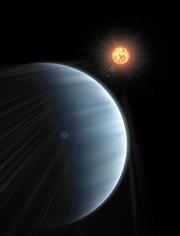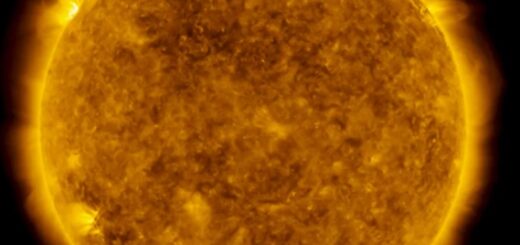A gaze at exoplanet haze

Spectroscopic observations of a distant planet swooping across the face of its sun have given astronomers a first-ever look at the atmosphere of an Earth-like planet lying beyond our Solar System. The new data don’t provide a precise list of gaseous constituents, but they do indicate that the atmosphere is not one of cloud-free hydrogen.
The planet, dubbed GJ 1214b when it was discovered late last year, tightly orbits a red-dwarf star about 13 parsecs from Earth. With a mass about 6.5 times that of Earth, it is one of the smallest exoplanets yet discovered, and previous observations suggest that the planet’s density is far too low for it to be a bare solid object with no atmosphere.
“There’s nothing like this planet in our Solar System,” says Jacob Bean, a planetary astronomer at the Harvard-Smithsonian Center for Astrophysics in Cambridge, Massachusetts.
For about 50 minutes during each 38-hour orbit, GJ 1214b passes directly in front of its star as we view it from Earth, a fortuitous circumstance that offers researchers a chance to observe light filtering through its atmosphere and glean clues about the gases swaddling the orb.
“It won’t be long until we’re probing the atmosphere of something that’s habitable.”
During two transits of GJ 1214b earlier this year, Bean and his colleagues observed the planet at narrow bands of wavelength ranging from the red to the near infrared. If the planet were surrounded by a hydrogen-dominated atmosphere — and assuming that our view is not obscured by clouds — trace amounts of water vapour at high altitudes would absorb the light more strongly at some of the observed wavelengths than at others, says Bean.
That pattern would cause GJ 1214b to appear to have a larger diameter at some wavelengths than at others. But the planet seemed to be a consistent size at all wavelengths that the researchers scrutinized. That indicates another type of atmosphere altogether, they report in Nature1 today.
Cloaked in cloud
For example, GJ 1214b could be cloaked in layers of clouds that block red and near-infrared wavelengths equally effectively. No known major constituents of planetary atmospheres could condense in the temperature and pressure conditions inferred for GJ 1214b (1200-1400°C and about 100 Earth atmospheres, if the atmosphere is mainly hydrogen). But the planet could be enveloped in layers of photochemical haze, as are Titan and Venus in our Solar System.
Or, the researchers say, the atmosphere may be composed of at least 70% water vapour — rendering GJ 1214b a perpetual sauna planet, if you will.
“I was stunned by the quality of their data,” says Drake Deming, a planetary astronomer at the NASA Goddard Space Center in Greenbelt, Maryland. “They’re exquisite.”
Current data don’t allow scientists to discriminate between the two alternatives, says Deming. However, he notes, “most of us would bet on cloudy and hazy”.
Observing transits of the planet at additional wavelengths — particularly in the far infrared, where clouds and haze tend to become transparent — would settle the debate, Deming suggests. Such observations, using sensors on the Hubble Space Telescope, have already been scheduled, and sensors on the yet-to-be-launched James Webb Space Telescope would also serve the purpose.
The trend towards discovering ever-smaller, ever-cooler exoplanets will soon culminate in something more familiar to Earthlings than the hundreds of super-hot, super-giant planets orbiting exotic stars, Bean contends: “It won’t be long until we’re probing the atmosphere of something that’s habitable.”



 Creators of mankind
Creators of mankind Description of “Tall white aliens”
Description of “Tall white aliens” Where they came from?
Where they came from? About hostile civilizations
About hostile civilizations The war for the Earth
The war for the Earth “Tall white aliens” about eternal life
“Tall white aliens” about eternal life Video: “Nordic aliens”
Video: “Nordic aliens” Aliens
Aliens Alien encounters
Alien encounters The aliens base
The aliens base UFO
UFO Technology UFO
Technology UFO Underground civilization
Underground civilization Ancient alien artifacts
Ancient alien artifacts Military and UFO
Military and UFO Mysteries and hypotheses
Mysteries and hypotheses Scientific facts
Scientific facts


















